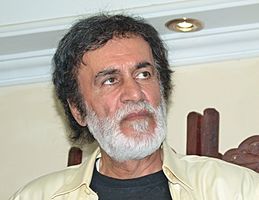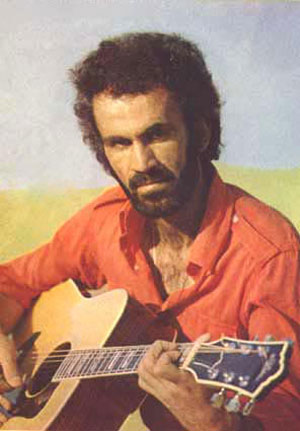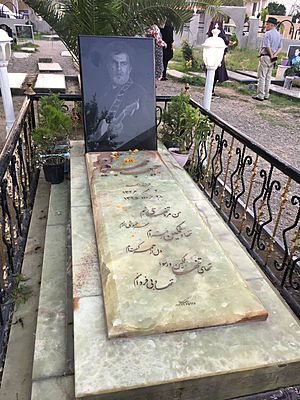Habib (singer) facts for kids
Quick facts for kids
Habib
|
|
|---|---|

Habib in August 2014
|
|
| Background information | |
| Birth name | Habib Mohebian |
| Born | 27 September 1947 Tehran, Iran |
| Died | 10 June 2016 (aged 68) Ramsar, Mazandaran, Iran |
| Genres | Persian Rock, Rock , pop, Country music |
| Occupation(s) | Singer, composer, musician |
| Instruments | Guitar, piano |
| Years active | 1970–2016 |
| Labels | Taraneh Records Avang Music Caltex Records |
| Associated acts | Mohammad Mohebian |
Habib Mohebian (Persian: حبیب محبیان; 26 September 1947 – 10 June 2016), known simply as Habib, was a famous Iranian singer, songwriter, and musician. Many people consider him one of the first artists to create rock music in Iran. He was special because he wrote all his own songs. He was also one of the few Iranian singers who played a special twelve-string guitar very well.
Contents
Habib's Early Life and Music Journey
Habib was born in Shemiran, Tehran province, Iran, on September 27, 1947. From a young age, he loved playing the guitar. When he was a teenager, popular bands like The Beatles were famous in Europe. This made him even more interested in music.
Habib passed an exam for radio and television. He then started learning how to compose music. He learned from a teacher named Morteza Hannaneh. Later, he became a singer on television. After working there for two years, he joined the military. He continued to sing for officers during his military service.
Habib's Music Career
Habib had a long and successful music career. He released many albums and popular songs.
Becoming Famous Before the Revolution
Habib released a very popular album called "Mard-e Tanha-ye Shab" in 1977. This album made him famous. The most well-known song from this album had the same name. Another famous song was "Shahlaye Man". He also released his second album, "Salam Hamsayeh," in 1978.
Moving to America
After some changes in the government in Iran, singing was not allowed for Habib. So, in 1983, he left Iran. He moved to Los Angeles, in the United States, in 1985. There, he became very popular again. His album "Bezan Baran" (1996) was a big hit. After that, he released another successful album called "Kavir-e Bavar" (1999). This album included the famous song "Kharchanghaye Mordabi".
Working with His Son, Mohammad
In 2002, Habib started performing with his son, Mohammad. Habib was flexible and made music videos and performed on stage. This helped his son's music career. Their first album together was called "Javuni".
Returning to Iran
In 2009, Habib traveled back to Iran. He asked the government if he could release new music and perform concerts. However, he was not allowed to do so. After returning to Iran, he only released a few single songs and music videos.
Habib's Family Life
Habib's first wife was named Shadi. They had a son together named Ahmadreza. After Shadi passed away, Habib married Nahid. Habib and Nahid had a son named Mohammad.
Habib's Passing
Habib passed away on Friday, June 10, 2016. He was 68 years old. He died from a cardiac arrest (a sudden stop of the heart). This happened in Niasteh village, Katalem, Ramsar.
Habib's Music Albums
- (1977) Mard-e Tanha-ye Shab
- (1978) Salaame Hamsayeh
- (1984) Aftab Mahtab
- (1988) Hamraz
- (1990) Khorshid Khanoom
- (1992) Akheh Azizam Chi Misheh?
- (1994) Sefr
- (1996) Bezan Baran
- (1999) Kavir-e Bavar
- (2001) Khodavanda
- (2002) Khane-ye Koochak
- (2004) Javuni
- (2006) Khodeshe (Feat Mohammad)
- (2008) Iran Banoo
Habib's Single Songs
- (2010) Shooneh Be Shooneh (Feat Ivan)
- (2010) Eshgh Khodaei
- (2012) Baran
- (2012) Abo Khaak
- (2012) Sara
- (2012) Mahkoom (Feat Samir Zand)
- (2013) To Naboodi
- (2014) Bebar ey barf
- (2014) God is great
- (2014) Naz gole baba
- (2014) Banooye sharghi
- (2015) Donya
- (2016) Goleh sorkh
- (2016) Mohkoom 2
- (2016) Donya (Remix)
- (2017) To Hosseini
- (2018) Yade Geryehat (Feat Mohamad)



